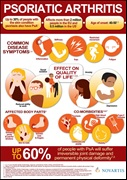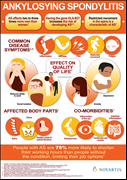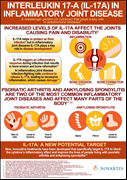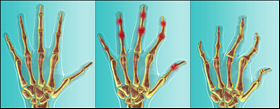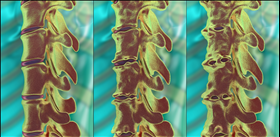Novartis presents new scientific evidence for Cosentyx in ankylosing spondylitis and psoriatic arthritis patients at EULAR 2016
· Up to 80% of ankylosing spondylitis and 84% of psoriatic arthritis patients treated with Cosentyx® at two years had no radiographic progression in the spine or joints,respectively1,2
· Cosentyx may improve the signs and symptoms of ankylosing spondylitis and psoriatic arthritis more than Humira®3,4 – based on new indirect comparative analyses
· New head-to-head clinical trials planned to compare Cosentyx versus Humira5
Basel, June 8 2016 – Novartis announced today that it will present 33 scientific abstracts at the Annual European Congress of Rheumatology (EULAR 2016) in London, UK. This includes new long-term analyses suggesting Cosentyx®(secukinumab) may lead to higher responses than Humira®* (adalimumab) in improving the signs and symptoms of people living with ankylosing spondylitis (AS) and psoriatic arthritis (PsA) at 52 weeks3,4. These analyses are from two studies using the Matching-Adjusted Indirect Comparisons (MAIC) method. MAIC is a valid and accepted method for comparative effectiveness research6,7.
To directly compare Cosentyx versus Humira, Novartis plans to initiate new head-to-head studies in patients with AS and PsA5. These will be the first ever adequately powered long-term head-to-head studies with biologic medicines to differentiate the effectiveness of treatment in these conditions.
“There is an urgent need for new ankylosing spondylitis and psoriatic arthritis treatments because a significant number of patients do not respond well to anti-TNF therapy, the current standard of care,” said Vasant Narasimhan, Global Head, Drug Development and Chief Medical Officer, Novartis. “There is a growing body of evidence that supports the potential of Cosentyx to become a gold standard of care for patients living with these debilitating conditions.”
Also presented at the Annual European Congress of Rheumatology (EULAR 2016) were two-year data showing that up to 80% of AS patients on Cosentyx had no radiographic progression in the spine on x-ray assessment1. A similar proportion of patients with PsA (84%), who were on Cosentyx for two years, also had no evidence of progression2.
More than 9,600 patients have been treated with Cosentyx in clinical trials across multiple indications, and over 20,000 patients with psoriasis have already been treated in the post-marketing setting5. The safety profile of Cosentyx was shown to be consistent with that seen in clinical trials across multiple indications8-10.
About MAIC and limitations of these studies
While these MAIC analyses have been performed using data from randomized controlled trials, there are limitations to these analyses due to differences in study designs and lower effective sample size for Cosentyx. In addition, only publicly available data has been used for Humira. This impacts availability of comparative data and matching of patient populations in these studies. Further technical details on the MAIC analyses are available in the presented scientific abstracts6,7.
About Cosentyx and interleukin-17A (IL-17A)
Cosentyx is a fully human monoclonal antibody that selectively neutralizes circulating IL-17A. Research suggests that IL-17A may play an important role in driving the body’s immune response in psoriasis, AS and PsA11,12.
Cosentyx is approved in more than 50 countries for the treatment of moderate-to-severe plaque psoriasis which includes the European Union countries, Japan, Switzerland, Australia, the US and Canada. In Europe, Cosentyx is approved for the first-line systemic treatment of moderate-to-severe plaque psoriasis in adult patients13. In the US, Cosentyx is approved as a treatment for moderate-to-severe plaque psoriasis in adult patients who are candidates for systemic therapy or phototherapy (light therapy)14.
In addition, Cosentyx is the first IL-17A inhibitor with positive Phase III results for the treatment of active AS and PsA8-10 and is now approved in Europe, the US, and other countries for these conditions. Cosentyx is also approved for the treatment of PsA and pustular psoriasis in Japan.
About ankylosing spondylitis
AS is part of a family of life-long inflammatory diseases that also includes PsA. It generally results in serious impairment of movement in the spine and physical function, which has an impact on quality of life. People in their teens and twenties, particularly males, are affected most often. Family members of those with AS are at higher risk15,16.
Improvements in the symptoms of AS are measured by the ASAS response criteria (ASAS20), which is defined as an improvement of at least 20% and absolute improvement of at least 10 units on a 0-100mm scale in at least three of the following criteria: improvement in flexibility, night time pain, ability to perform specific tasks, morning stiffness, and no further deterioration in the condition. The percentage of patients reaching an ASAS20 response is an accepted way of measuring the efficacy of treatments in AS17.
About psoriatic arthritis
PsA is part of a family of life-long inflammatory diseases that also includes AS. It is also closely associated with psoriasis. Approximately 30% of patients with psoriasis have PsA18 and as many as one in four people with psoriasis may have undiagnosed PsA19. Symptoms of PsA include joint pain and stiffness, skin and nail psoriasis, swollen toes and fingers, persistent painful swelling of the tendons, and irreversible joint damage20. Up to 40% of people can suffer from joint destruction and permanent physical deformity21.
Improvements in the symptoms of PsA are measured by the ACR response criteria, which has three levels – ACR20, 50, 70. In ACR20 there is an improvement of 20% or greater of the following criteria: reduction in the number of tender joints; reduction in the number of swollen joints; and a reduction in three of five additional criteria, which are the patient’s assessment of pain and/or the patient’s assessment of how active his or her PsA is, the physician’s assessment of disease activity, levels of disability measured by the Stanford Health Assessment Questionnaire, and laboratory tests showing if inflammation is active. The ACR50 and ACR70 use the same criteria as ACR20, but are looking for a higher percentage improvement (50% and 70%) instead of 20%22.
*Humira is a registered trademark of AbbVie Inc.
Disclaimer
The foregoing release contains forward-looking statements that can be identified by words such as “may,” “planned,” “will,” “suggesting,” “plans,” “growing,” “potential,” “suggests,” or similar terms, or by express or implied discussions regarding potential new indications or labeling for Cosentyx, or regarding potential future revenues from Cosentyx. You should not place undue reliance on these statements. Such forward-looking statements are based on the current beliefs and expectations of management regarding future events, and are subject to significant known and unknown risks and uncertainties. Should one or more of these risks or uncertainties materialize, or should underlying assumptions prove incorrect, actual results may vary materially from those set forth in the forward-looking statements. There can be no guarantee that Cosentyx will be submitted or approved for any additional indications or labeling in any market, or at any particular time. Nor can there be any guarantee that Cosentyx will be commercially successful in the future. In particular, management’s expectations regarding Cosentyx could be affected by, among other things, the uncertainties inherent in research and development, including unexpected clinical trial results and additional analysis of existing clinical data; unexpected regulatory actions or delays or government regulation generally; the company’s ability to obtain or maintain proprietary intellectual property protection; general economic and industry conditions; global trends toward health care cost containment, including ongoing pricing pressures; unexpected safety, quality or manufacturing issues, and other risks and factors referred to in Novartis AG’s current Form 20-F on file with the US Securities and Exchange Commission. Novartis is providing the information in this press release as of this date and does not undertake any obligation to update any forward-looking statements contained in this press release as a result of new information, future events or otherwise.
